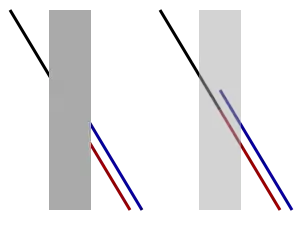Poggendorff illusion
The Poggendorff illusion is a geometrical-optical illusion that involves the misperception of the position of one segment of a transverse line that has been interrupted by the contour of an intervening structure. It is named after Johann Christian Poggendorff, the editor of the journal, who discovered it in the figures Johann Karl Friedrich Zöllner submitted when first reporting on what is now known as the Zöllner illusion, in 1860.[2] The magnitude of the illusion depends on the properties of the obscuring pattern and the nature of its borders.[3]

Many detailed studies of the illusion, including "amputating" various components[4][5] point to its principal cause: acute angles in the figure are seen by viewers as expanded[6][7] though the illusion diminishes or disappears when the transverse line is horizontal or vertical. Other factors are involved.[8][9]
References
- Greist-Bousquet S.; Schiffman H.R. (1981). "The Poggendorff illusion: an illusion of linear extent?". Perception. 10 (2): 155–64. doi:10.1068/p100155. PMID 7279544.
- Zöllner F (1860). "Ueber eine neue Art von Pseudoskopie und ihre Beziehungen zu den von Plateau und Oppel beschriebenen Bewegungsphaenomenen". Annalen der Physik. 186 (7): 500–25. Bibcode:1860AnP...186..500Z. doi:10.1002/andp.18601860712.
- Westheimer G, Wehrhahn C (1997). "Real and virtual borders in the Poggendorff illusion". Perception. 26 (12): 1495–501. doi:10.1068/p261495. PMID 9616477.
- Day, R.H. (1973). "The oblique line illusion: The poggendorff effect without parallels". The Quarterly Journal of Experimental Psychology. 25 (4): 535–541. doi:10.1080/14640747308400375. PMID 4767535.
- Spehar B, Gillam B J, 1998, "Modal and amodal completion in the Poggendorff illusion" Perception 27 ECVP Abstract Supplement
- Weintraub, D.J., Krantz, D.H., & Olson, T. (1980). The Poggendorff illusion: consider all the angles. J. exp. Psychol. Hum Percept Perform., 6 718-725
- Morgan M.J. (1999). "The Poggendorff illusion: a bias in the estimation of the orientation of virtual lines by second-stage filters". Vision Research. 39 (14): 2361–2380. doi:10.1016/S0042-6989(98)00243-0. PMC 4213454. PMID 10367057.
- Green R.T.; Hoyle E.M. (1963). "The Poggendorff Illusion as a Constancy Phenomenon". Nature. 200 (4906): 611–612. Bibcode:1963Natur.200..611G. doi:10.1038/200611a0. PMID 14082259.
- Gregory, R.L. (1968). "Perceptual Illusions and Brain Models". Proceedings of the Royal Society B. 171 (1024): 279–296. Bibcode:1968RSPSB.171..279G. doi:10.1098/rspb.1968.0071. JSTOR 75828.